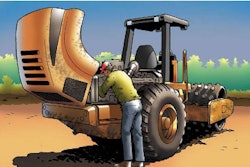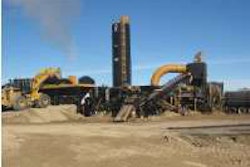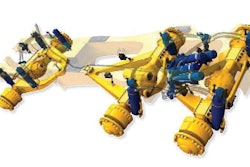A good used compact excavator – also called a mini excavator – can give you the maneuverability and versatility you may be missing with your larger machines.
In order to make a solid buying decision though, you’ll need to give a used compact excavator a thorough inspection. We asked Mike Whittaker, senior shop technician with Gregory Poole Equipment, Raleigh, North Carolina, to give us a roadmap for inspecting these machines. He chose as his inspection machine a Caterpillar 303 CR with 3,000 hours.All good inspections start with a walk around, which will highlight any obvious problems, some of which may stop you from exploring further.
 TRACKS — Anchor the machine with the bucket on one side, and tilt it up. Then run the track on the elevated side, looking for cuts, missing chunks or dry rot in the rubber. Repeat on the other side.
TRACKS — Anchor the machine with the bucket on one side, and tilt it up. Then run the track on the elevated side, looking for cuts, missing chunks or dry rot in the rubber. Repeat on the other side.Looking for leaks at this point is especially critical, Whittaker says. “Check for leaks in the hoses and cylinders, and especially under the machine,” Whittaker says. “You don’t want to start the machine with a major leak or a torn out bottom.”
Then examine the frame, ROPS, boom, stick and blade welds for any cracks. “On welds that have started to crack, you can see a line of rust where the bare metal is exposed,” Whittaker says. Look at the steps and grab irons, making sure the steps aren’t bent and they’re secure. And note any missing safety decals. Does the machine need to be repainted?
 CYLINDER — Look for any leaks or pitting on all cylinders. Examine seals for leaks, and check all pins and bushings for looseness.
CYLINDER — Look for any leaks or pitting on all cylinders. Examine seals for leaks, and check all pins and bushings for looseness.Open up each service compartment, noting whether the latches work. Make sure the fuel tank cap and strainer are in place and working. Judge whether the battery is secure or if there’s evidence of corrosion on the terminals.
Look for oil seepage in the boom and stick cylinders, or if there are damaged hydraulic lines. Are all brackets in place?
Operational checks
Start the machine and get it up to operating temperature. Whittaker then runs it through a series of operational checks:
• Do several simulated digging cycles with the boom, stick and bucket. Then swing the boom left and right, extending the stick and opening and closing the bucket. Look for any looseness in the pins and bushings or coupler.
• Operate the blade up and down. Raise the front of the machine with the blade.
• Swing the upper body to the left and right, again checking for hesitations. Brake during each rotation, and note the response.
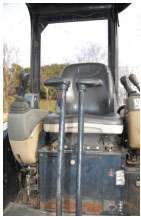 OPERATOR’S STATION — While running the machine, check the operation of all controls and gauges. Make sure the seat adjusts and the seat belt is in good condition. If the cab is enclosed, operate the air conditioning and note any glass, mirror or door latch problems.
OPERATOR’S STATION — While running the machine, check the operation of all controls and gauges. Make sure the seat adjusts and the seat belt is in good condition. If the cab is enclosed, operate the air conditioning and note any glass, mirror or door latch problems.• Run the machine in forward and in reverse and turn left and right with the tracks. Are the controls operating smoothly? Does the backup alarm work?
• Moving the boom to one side and using the bucket as an anchoring point, lift the machine and run the elevated track, checking for any cuts, missing chunks or dry rot in the rubber. Make sure it rotates freely. Repeat on the other side.
While you’re in the seat
During your operational checks, listen for unusual engine noises. Also note whether gauges, lights and the horn work properly. Are the mirrors intact? Make sure the seat is in good condition, fully adjusts, the seat belt is operational and the safety and operator’s manuals are in place. If your machine has an enclosed cab, check the door latches, note any cracks in the glass, and whether the window wipers and air conditioning work.
Step out of the cab and open the engine compartment to check for blow-by. “I’ll pull out the dipstick and feel for pressure,” Whittaker says. “Some will be normal, but if the pressure is excessive you probably have some power issues.”
Delve deeper
 BUCKET — Check the size, linkage and mounts on the bucket and the condition of the quick coupler.
BUCKET — Check the size, linkage and mounts on the bucket and the condition of the quick coupler.Now that you’ve put the machine through its paces, do another walk around, this time delving deeper into the service compartments. “I look at the general cleanliness,” Whittaker says, “and whether the engine compartment is full of dirt or the radiator has debris.”
In the engine compartment, check for oil leaks in the valve covers, seals and oil pan. Examine all fluid levels – engine and hydraulic oil, plus coolant levels. Note the oil condition – if it’s black, then it probably has been awhile since the oil was changed. Check for water in the engine oil. Note the color of the antifreeze. Make sure all filters show current dates and are in good condition.
Note the color of the antifreeze. Make sure the water pump, fan and hoses are working properly. The fuel tank cap and strainer need to be in place and working. Check to see if the battery is secure, and there’s no evidence of corrosion on the terminals.
 UNDERNEATH — Carefully inspect the machine underneath for major leaks. Also note the condition of the blade.
UNDERNEATH — Carefully inspect the machine underneath for major leaks. Also note the condition of the blade.If your machine has a steel undercarriage, look at the pins and bushings, track shoes, idlers, carrier rollers and links. Determine the percentage of wear remaining.
Finally, ask for maintenance records and an oil sample history. If this is a machine you’re serious about, get an oil sample tested and compare it to past oil samples.
Check out the checklist below for a full list of what to look for.
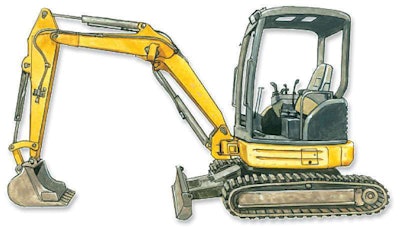 STRUCTURE — Examine the frame, boom, stick and blade welds for cracks. A telltale sign: lines of rust showing where the bare metal is exposed. Make sure all steps and grab irons are in good shape and all compartment latches and locks work. ENGINE COMPARTMENT — Note any oil leaks. While the machine is running, check for smoke and knocks, blow-by, compression in the radiator and water in the oil. Examine the condition of all filters and fluid levels. Look at all cooling system components, including radiator, water pump, fan, fan drive and hoses.
STRUCTURE — Examine the frame, boom, stick and blade welds for cracks. A telltale sign: lines of rust showing where the bare metal is exposed. Make sure all steps and grab irons are in good shape and all compartment latches and locks work. ENGINE COMPARTMENT — Note any oil leaks. While the machine is running, check for smoke and knocks, blow-by, compression in the radiator and water in the oil. Examine the condition of all filters and fluid levels. Look at all cooling system components, including radiator, water pump, fan, fan drive and hoses.
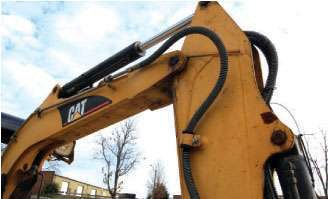
Look for leaks, cuts and abrasion wear on all hoses.
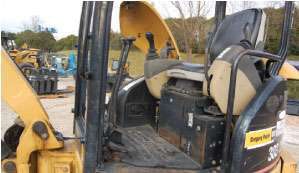 Run all controls and check the operation of gauges and switches. Make sure floor boards and mats are in place.
Run all controls and check the operation of gauges and switches. Make sure floor boards and mats are in place.
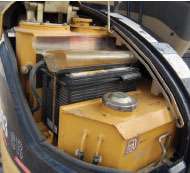 The battery should be well secured with no corrosion on the terminals.
The battery should be well secured with no corrosion on the terminals.
Used Compact Excavator Checklist
Make/model:
Engine make/model:Number of hours:
Serial number:
O
il sample results:Service records:
Walk around condition check
Radiator grill and shroud
Service compartment doors, hardwareEngine enclosureFuel tank
Battery box
Main frame welds
Body
Steps and grab irons
Paint
Engine
Oil leaks
Blow byKnocking
Compression in radiator
Water in oil
Fluid levels OK?
EPA decal
Antifreeze color
Oil pressure
Smoke
Filters
Oil filter condition
Belts/pulleys
Exhaust/muffler
Cooling system
Water pump
Fan
Hoses
Radiator
Coolers
Fan drive
Electrical systems
Batteries/cables
Starter
Alternator
Wiring
Lighting
Hydraulics
Operating condition
Pump drive
Pumps and valves
Boom cylinder
Stick cylinder
Bucket cylinder
Hose lines
Control linkage
Swing gear
Thumb cylinder
Tank
Swing motors
Travel motors
Hydraulic swivel
Filter condition
Undercarriage
Rubber or steel?
Rubber
• Cracks
• Chunks
Steel
• Pins and bushings
• Track shoes
• Idlers
• Carrier rollers
• Links
• Segments
• Percentage of life remaining?
Boom
Pins and bushings
Boom condition
Boom pins
Stick
Pins and bushings
Stick condition
Stick pins
Bucket
Size
Linkage
Mounts
Quick coupler
Safety items
Cab guards
ROPS
Safety decals in place and legible?
Horn
Brake hold
Swing brake
Backup alarm
Cab
Gauges
Switches
Interior lights
Dash console
Seat condition
Mirrors
Floor boards, mats
Safety and operators manuals present?
If enclosed:
Door latches
Windshield wipers
Heater
Air conditioner
Glass
List any attachments and their condition:
History/comments
Comments of previous owner or seller Detail any recent repairs and rebuilds and who did them Condition of maintenance records – available electronically? Note any repairs and estimated costs





